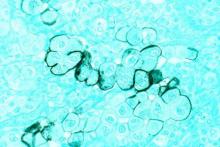Pancreatic cancer patients who received neoadjuvant therapy (NAT) followed by resection had better outcomes than did those who underwent upfront resection, investigators report.
Among patients with clinical stage I or II resected pancreatic head adenocarcinoma, the median survival was higher among those who had received NAT, compared with those who had upfront resection (26 months vs. 21 months; P less than .01).
The survival benefit remained consistent for both clinical stage I (29 months vs. 23 months; P less than .01) and clinical stage II (24 months vs. 20 months; P less than .01).
“This study lends further support for the use of NAT as a favorable patient selection strategy in the management of resectable, early-stage pancreatic adenocarcinoma,” wrote Ali A. Mokdad, MD, of the University of Texas Southwestern Medical Center, Dallas, and his colleagues (J Clin Oncol. 2016 Sep 19. doi: 10.1200/JCO.2016.68.5081).
The researchers compared overall survival between patients who received NAT with subsequent resection with those who received upfront resection, and they also looked at the patient subset of those who received adjuvant therapy.
The cohort included 15,237 patients with clinical stage I or II resected pancreatic head adenocarcinoma who were identified from the National Cancer Database (2006-2012). The patients who received NAT followed by curative-intent resection were matched with patients whose tumors were resected upfront, and the researchers evaluated early postoperative and oncologic outcomes.
Overall survival at 1, 3, and 5 years was 83%, 35%, and 21% in the NAT arm, compared to 71%, 29%, and 18% among patients who underwent upfront surgery, respectively. In the NAT arm, overall mortality was reduced, with an estimated hazard ratio (HR) of 0.72 (95% CI, 0.68-0.76).
In comparison with the subset of patients who received adjuvant therapy, median survival was statistically significantly longer in the NAT group (26 months vs. 23 months; stratified log-rank P less than .01). Overall survival for the adjuvant therapy group at 1, 3, and 5 years was 78%, 31%, and 18%, respectively.
Upon multivariable analysis, the overall survival difference continued to favor the NAT group vs. the adjuvant therapy arm (adjusted HR, 0.83; 95% CI, 0.78-0.89).
Early postoperative morbidity and mortality did not differ between groups. Compared with patients who received NAT, the upfront surgery group had a higher pathologic T stage (pT3 and T4: 86% vs. 73%; P less than .01) and were more likely to have positive lymph nodes (73% vs. 48%; P less than .01) and positive resection margin (24% vs. 17%; P less than .01).
The data “will hopefully provide support and encouragement for participation in the currently open clinical trials evaluating the role of NAT for clinically staged patients with resectable pancreatic cancer,” the authors concluded.
No outside funding source was disclosed. Coauthor Sam C. Wang, MD, declared a relationship with patent/intellectual panel for a prognostic gene panel for gastric cancer. All other authors declared no disclosures.


